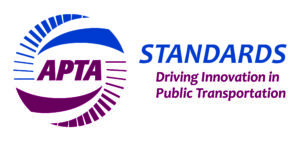The December 2024 ransomware attack on Pittsburgh Regional Transit wasn’t unique. It was the fourth major cyberattack on U.S. transit systems in twelve months. While agencies scramble to respond, APTA’s Operational Technology Cybersecurity Maturity Framework offers a structured path forward. Those who have worked to support safety and security for transit projects know that understanding the framework is straightforward. Implementing it effectively presents the real challenge.
The Framework’s Six Levels: Theory Meets Reality
APTA’s OT-CMF presents six maturity levels, from Level 0 (foundation) through Level 5 (optimized). The framework explicitly states that most agencies should target Level 3 as their goal. While that is refreshingly realistic, a look at what’s required to reach Level 3 shows there are significant challenges that the framework doesn’t fully address.
maturity levels, from Level 0 (foundation) through Level 5 (optimized). The framework explicitly states that most agencies should target Level 3 as their goal. While that is refreshingly realistic, a look at what’s required to reach Level 3 shows there are significant challenges that the framework doesn’t fully address.
Level 0 and 1 focus on establishing basic governance, asset identification, and security awareness. These foundational steps sound straightforward until you’re dealing with a 30-year-old train control system running on proprietary protocols with no documentation. Asset identification alone can take months when your OT environment includes everything from 1990s relay-based interlockings to modern CBTC systems.
Level 2 introduces formal governance committees and zone architecture definition. This is where IT and OT cultures collide. Your IT security team speaks in NIST controls and zero-trust architectures. Your OT team thinks in terms of safety integrity levels and mean time between failures. Building a governance committee that bridges this gap requires more than executive approval — it requires fundamental culture change.
Level 3, the recommended target, demands continuous monitoring, third-party audits, and systematic control implementation. For an average-sized transit agency, this represents approximately $2-3 million in annual operational costs, excluding initial implementation. The framework doesn’t mention that achieving Level 3 typically requires 18-24 months and a dedicated OT security staff that most agencies don’t have.
Levels 4 and 5 envision automated threat response and board-level cyber oversight. While aspirational, these levels assume resources and organizational maturity that perhaps five transit agencies nationwide currently possess.
The Hidden Implementation Challenges
The framework assumes agencies have clear boundaries between IT and OT systems. In reality, modern transit operations blur these lines constantly. Your passenger information system pulls data from train control. Your maintenance management system needs real-time vehicle diagnostics. Your fare collection system interfaces with banking networks. Each connection is a potential vulnerability, and the framework’s zone architecture model struggles with these hybrid systems.
Legacy system integration presents another unaddressed challenge. When your newest rail line uses Ethernet-based train control while your oldest uses hard-wired relay logic, implementing consistent security controls becomes exponentially complex. The framework’s tiered control structure doesn’t account for systems that literally cannot support modern security measures.
Resource allocation remains a critical unaddressed issue. The framework recommends annual third-party assessments starting at Level 2. A comprehensive OT security assessment for a mid-sized transit agency costs $150,000-$300,000. Add continuous monitoring tools, staff training, and control implementation, and you’re looking at millions in unbudgeted expenses while agencies struggle to maintain basic service levels.
A Pragmatic Path Forward
The framework’s levels exist for a reason. They establish predictable capabilities that regulators, partners, and incident responders can rely on during coordinated threats. Cherry-picking controls creates dangerous gaps and false confidence. The challenge is achieving each level systematically despite resource constraints. Here’s how to approach sequential implementation realistically:
1. Leverage existing safety processes.
Your System Safety Program Plan already documents critical assets and hazards. Your Security and Emergency Preparedness Plan identifies threats and vulnerabilities. Integrate cybersecurity into these existing frameworks rather than creating parallel processes.
2. Focus on segmentation before sophistication.
Basic network segregation between critical OT systems and corporate IT provides more immediate risk reduction than complex monitoring solutions. A properly configured firewall between your train control network and corporate systems delivers more value than an expensive SIEM that nobody knows how to use.
3. Build security into procurement.
Every new system, upgrade, or maintenance contract is an opportunity to improve your security posture. Require vendors to support modern authentication, provide security patches, and document all external connections. This costs nothing extra but pays dividends over system lifecycles.
4. Establish practical governance.
Instead of forming new committees, add cybersecurity as a standing agenda item to existing safety and operations meetings. Your operations team already meets weekly. Use five minutes to review security events and emerging threats.
5. Prioritize implementation within each level based on consequence.
While you must complete all controls to achieve a level, implement the most critical ones first. Within Level 1’s requirements, start with controls protecting safety-critical systems. A documented security policy matters less than securing your train control network. Complete the level, but sequence implementation based on operational risk.
Moving from Framework to Action
 The APTA OT-CMF provides valuable structure, but successful implementation requires translating its academic approach into operational reality. The framework’s standardized levels ensure that when threats emerge, every Level 3 agency has predictable defensive capabilities. Agencies need implementation roadmaps that acknowledge budget constraints, legacy system limitations, and organizational readiness while still achieving complete levels.
The APTA OT-CMF provides valuable structure, but successful implementation requires translating its academic approach into operational reality. The framework’s standardized levels ensure that when threats emerge, every Level 3 agency has predictable defensive capabilities. Agencies need implementation roadmaps that acknowledge budget constraints, legacy system limitations, and organizational readiness while still achieving complete levels.
Start by conducting a pragmatic gap assessment. Focus on a targeted evaluation of where you are versus where you need to be for your specific risk profile. A commuter rail operation faces different threats than a bus rapid transit system. Your assessment should reflect your operational reality rather than generic best practices.
Develop a phased implementation plan aligned with your capital program. Major system upgrades and expansions provide natural opportunities to improve security architecture. When planning a new rail extension project, build security requirements into the design from day one. It’s far cheaper than retrofitting security into operational systems.
Security perfection remains unattainable, yet meaningful improvement is achievable. The goal is to systematically reduce risk while maintaining safe, reliable transit service, rather than implementing every control in the framework.
The Bottom Line
APTA’s OT-CMF offers valuable guidance without being a turnkey solution. Success requires understanding both what the framework offers and what it omits. Transit agencies need partners who understand the operational constraints, budget realities, and technical debt that define the real world of transit cybersecurity.
The recent surge in transit cyberattacks makes clear that inaction is no longer viable. Blindly following a framework without considering your unique operational context is equally problematic. The path forward requires pragmatic assessment, risk-based prioritization, and systematic improvement aligned with your agency’s capabilities and constraints.
About Soteria Company
Soteria Company specializes in safety, security, and assurance for passenger transit systems. With over 20 years of experience supporting major transit agencies including LA Metro, Sound Transit, and Valley Metro, we understand the intersection of operational technology, safety certification, and cybersecurity. Our approach integrates security requirements into existing safety processes, leveraging your current investments while building toward a more secure future.
Ready to discuss a pragmatic approach to OT cybersecurity for your agency? Contact us from our website at www.soteriacompany.com to explore how we can support your cybersecurity maturity journey.
Sources
- American Public Transportation Association. APTA SS-CCS-RP-006-23 Operational Technology Cybersecurity Maturity Framework (OT-CMF) Overview. May 23, 2023.
- Cybersecurity & Infrastructure Security Agency. Transportation Systems Sector-Specific Plan. 2024.
- Federal Transit Administration. Cybersecurity Resources for Transit Agencies. 2024.
- McKinsey & Company. How to enhance the cybersecurity of operational technology environments. March 2023.
- Transportation Security Administration. Surface Transportation Cybersecurity Toolkit. 2024.
- TSA Notice of Proposed Rulemaking for Enhancing Surface Cyber Risk Management. November 2024.



